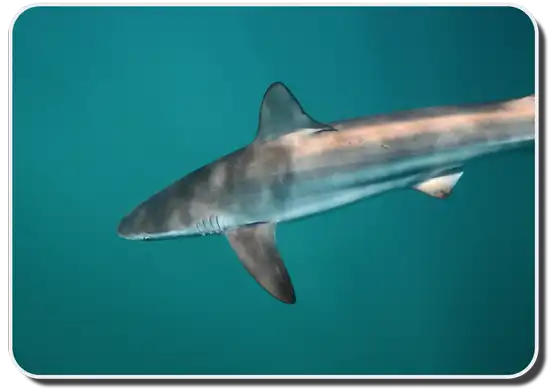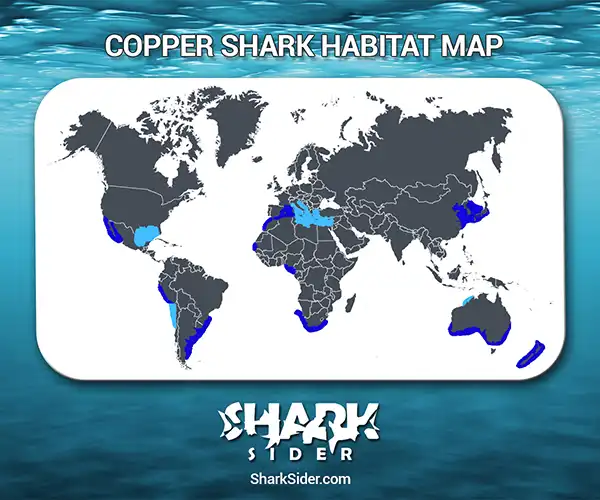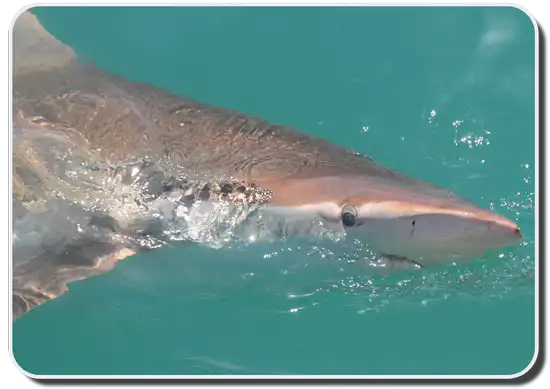The Copper Shark (Carcharhinus brachyurus) is a coastal species that can grow up to 3.5 m (11.6 ft) long. It is a “Requiem Shark” (family Carcharhinidae), which are large sharks like the Tiger Shark that are usually found in warm seas. This one is also known by many other common names including Narrowtooth Shark, Bronze Shark, Cocktail Shark, Bronze Whaler, and New Zealand Whaler.

It is easily confused with other large requiem sharks, including members of the same genus such as the Blacktip Shark, (C. limbatus) and the Spinner Shark (C. brevipinna). However this one is known for having distinct, narrow upper teeth which are hook-shaped, the absence of a prominent ridge between the dorsal fins, and its plain bronze color.
Like other large sharks, this species is vulnerable to human pressures such as fishing and habitat destruction.
Copper Shark Facts
The genus name Carcharhinus is Greek for sharp nose, a fitting description for this long, torpedo-shaped fish. The skin color is bronze on the back with a white belly. The fins have dark markings along the edges and white or dusky tips.
The Copper Shark is the only member of the genus that lives mostly at temperate latitudes, preferring warm / subtropical rather than tropical waters.
The heaviest known individual weighed 304.6 kg (670 lb), and the oldest known age is 30 years.
Tagging studies in Australia show that adults sometimes return to the same areas year after year. The maximum distance travelled by one individual in a study in South Africa was 1,320 km (825 miles)!
Habitat and Range
Map Of The Copper Shark Shark’s Habitat

This coastal, offshore shark lives almost worldwide, in deep, warm temperate and subtropical waters. But while widespread, it has a patchy distribution. It also frequents shallow areas, in either brackish (slightly salty) or freshwater. It has been spotted in large bays, rivers, harbor channels, and in the surf zone.
The Copper Shark can also be found near the sea bottom: it has been recorded down to 100 m (333 ft) but probably dives down even deeper.
Coastal areas where it is seen regularly include southern Africa, Australia and New Zealand, the Mediterranean, the Indo-Pacific, Argentina, southern California and the Gulf of Mexico. This shark is known to migrate with the seasons in the northern part of its range, heading northward in spring/summer and returning southward in autumn/winter. These shifts in latitude are thought to be linked to temperature changes or prey migration.
There is no available information about population sizes. They are thought to be distinct from one another, meaning that movement of individuals between populations is not common.
Feeding Behavior
This is an active fish. Fast-swimming Copper Sharks are skilled predators that often hunt in large groups. They have sophisticated hunting tools including their senses of vibration and electro-conductivity.
Adults feed on bony fish, cephalopods (squid and octopus), and small sharks and rays; larger individuals that are greater than 2m long are the most likely to eat other sharks. Juveniles also feed on jellyfish and crustaceans. The species follows the annual sardine run along the coasts of southern Africa, as do many other large predatory fish.
Social Behavior
Copper Sharks form schools of hundreds of individuals – perhaps related to breeding behavior or the local abundance of prey – but they are also often spotted alone.
These fish are separated in space by both size and sex:
Juveniles are found in shallow water (less than 30 m / 100 ft depth) year round, while adults are only abundant inshore during spring and summer. Adults are found over the continental shelf and around offshore islands and banks throughout the year.
Adult males are found in subtropical areas throughout the year. They are apart from females and young for most of the year: females conduct seasonal migrations, moving into subtropical regions during the winter.
Breeding
Most adult females return to temperate regions to breed. The mating process involves biting which can lead to minor injuries. The normal mating period is October – December. For these and other Requiem sharks, breeding usually occurs every other year and it is “Viviparous“: the developing embryos are nourished inside the mother’s body through a placenta formed from the yolk sac.

The gestation period (pregnancy) is estimated at from 12 to 21 months. Females give birth in coastal nursery areas from June to January. The large nurseries occur in well-protected areas such as shallow banks and bays, inlets and harbors, as well as the open coast. These areas also often serve as nurseries for other common coastal sharks.
Litters contain from 7 to 24 pups, which measure about 60 cm in length (24″). Growth is very slow, with males and females reaching maturity at 13-19 and 19-20 years of age, respectively. The lifespan is estimated at 25 to 30 years, although the maximum age is unknown. Productivity (production of offspring) is also thought to happen at a very low rate.
Humans and Conservation
Copper Sharks are not considered especially dangerous to people, but there have been many non-fatal attacks, typically on spear fishers and swimmers. Shark attacks on humans are rare, but about half of all reported attacks are from Requiem sharks.
Requiem sharks in general are treated as a valuable resource worldwide. They are used for their ?esh, ?ns, oil, and skin. They are prized as game fish, and they are caught as Bycatch in many different types of fisheries. For example, these sharks are regularly caught with other, more highly valued species such as tuna and swordfish. Catch data are usually grouped together for all Carcharhinus Sharks, meaning that any population declines could be easily overlooked.
This species is highly vulnerable to population decline due to its low growth and reproductive rates. Coastal nursery areas are also at risk from development and pollution. Thus the International Union for Conservation of Nature (IUCN) has assessed it as Near Threatened (2003).
Even worse for the species, the majority of animals affected by fisheries, pollution or habitat destruction in those inshore areas are likely to be juveniles and pregnant females, because of the nursing areas. The effects of human development are thought to be greatest in parts of the Mediterranean Sea and East Asia. Marine aquaculture is also a potential threat to nursery areas in New Zealand.
There are some designated conservation actions to protect this species in Australia and New Zealand.
Sources
- Duffy C & Gordon I (2003). Carcharhinus brachyurus. In: IUCN 2012. IUCN Red List of Threatened Species. Version 2012.2.
- FishBase
- Grace, MA (2001). Field guide to Requiem sharks (Elasmobranchiomorphi: Carcharhinidae) of the Western North Atlantic. U.S. Dep. Commer., NOAA Tech. Rep. NMFS 153, 32 p.
- Ocean Oasis
- Shark Foundation
- Shark Trust
- Wikipedia
